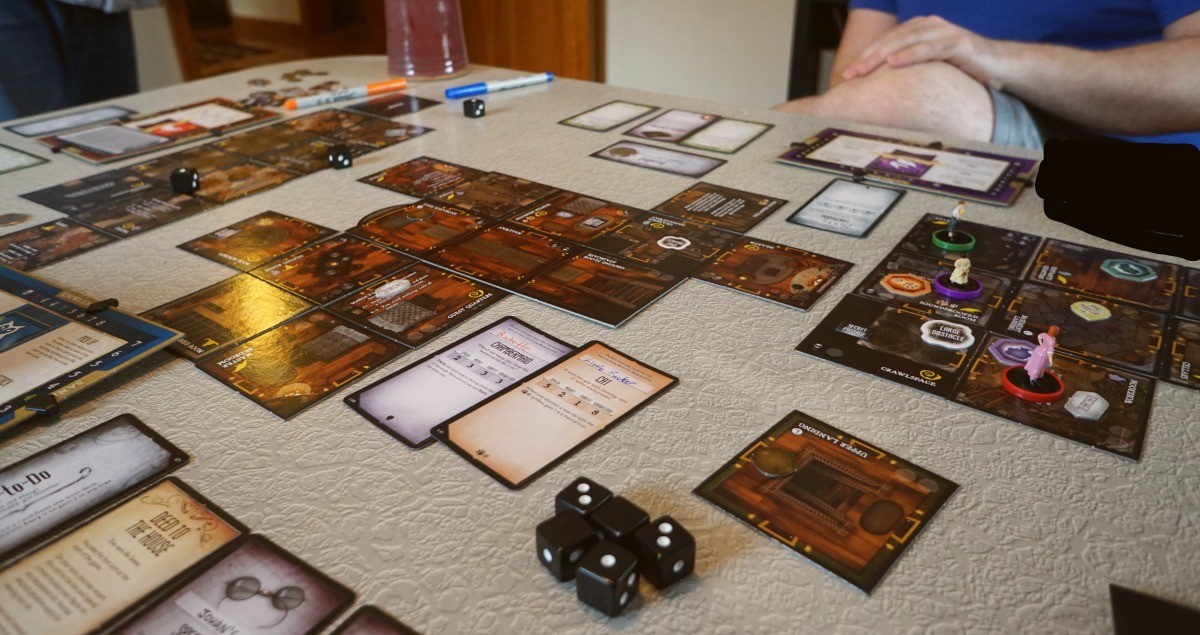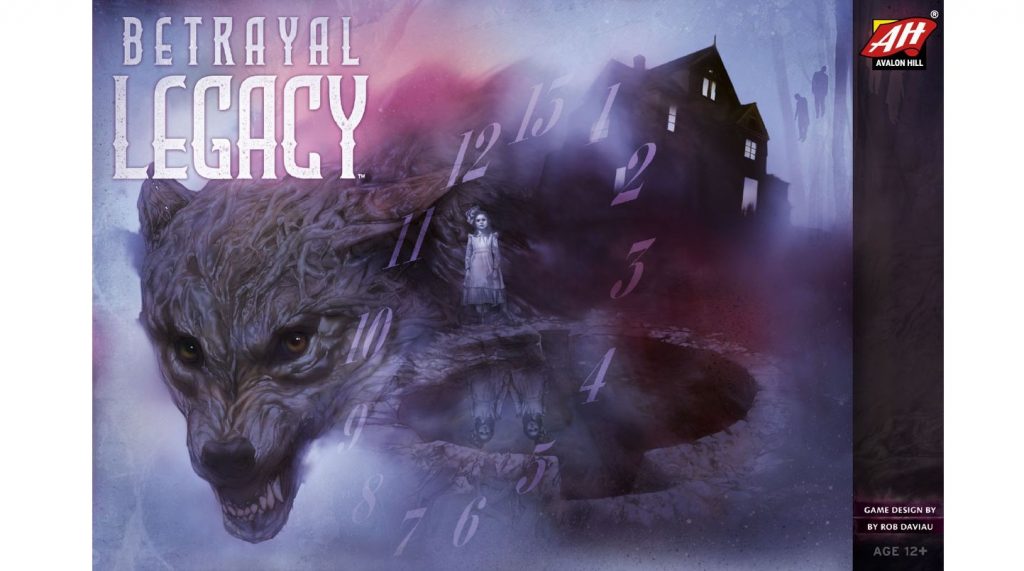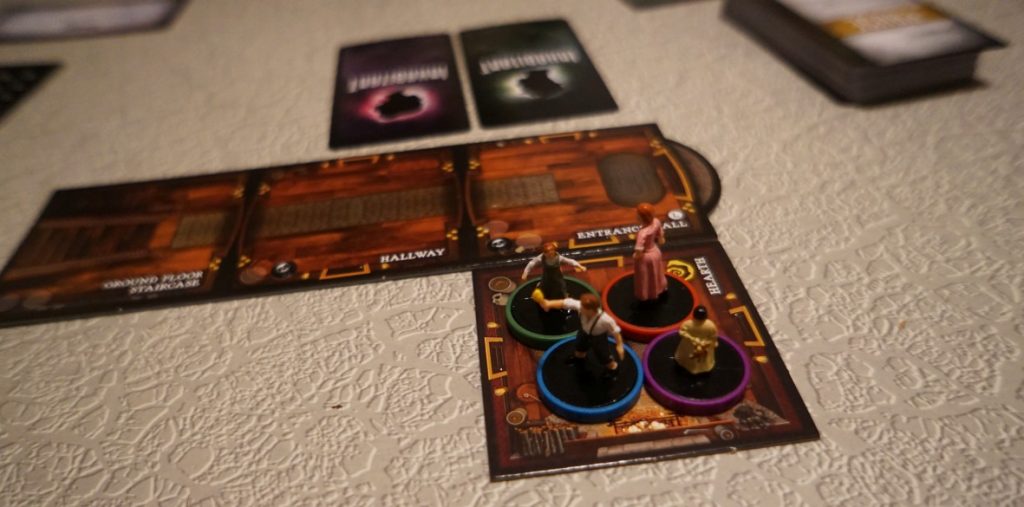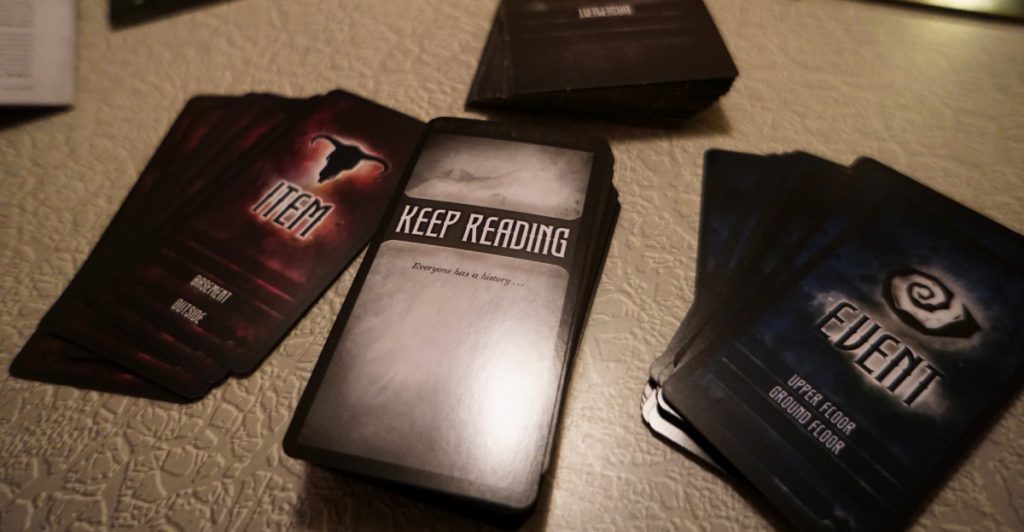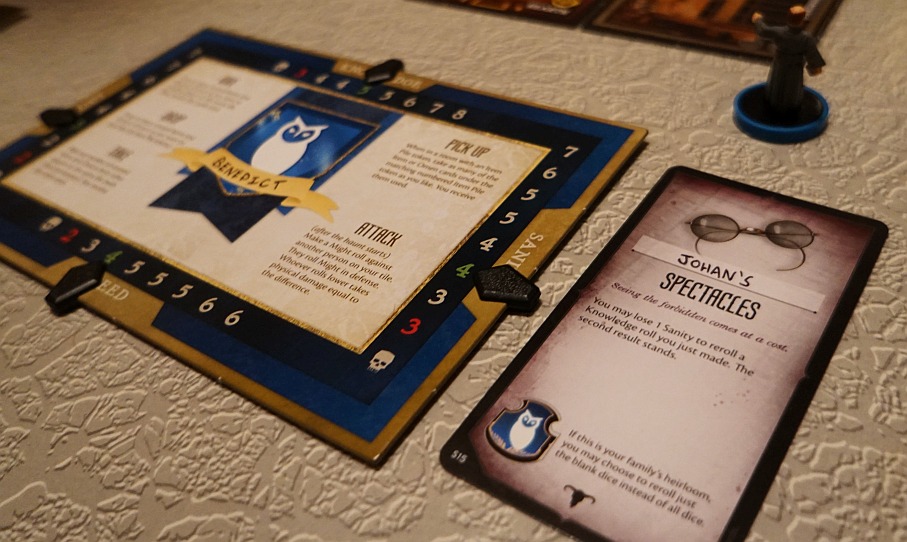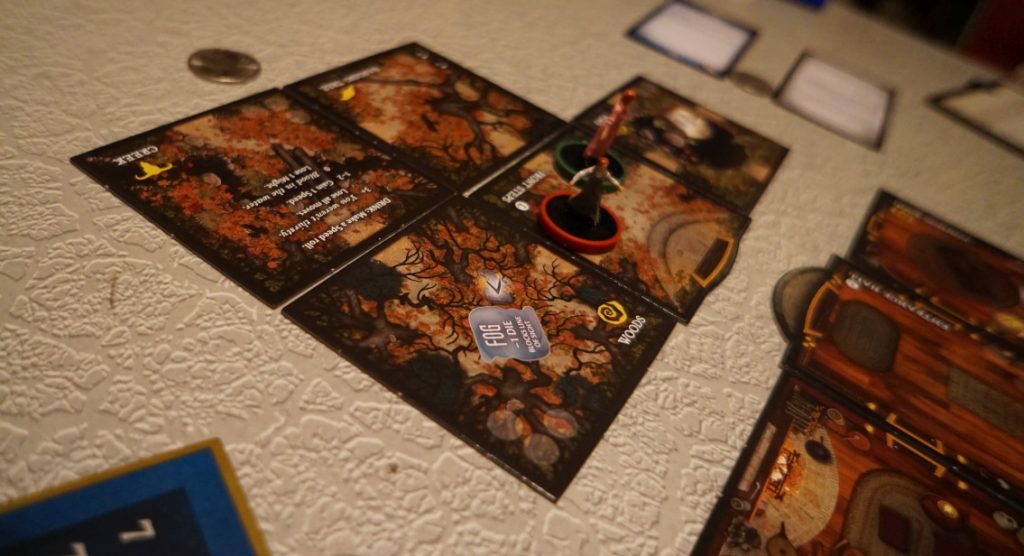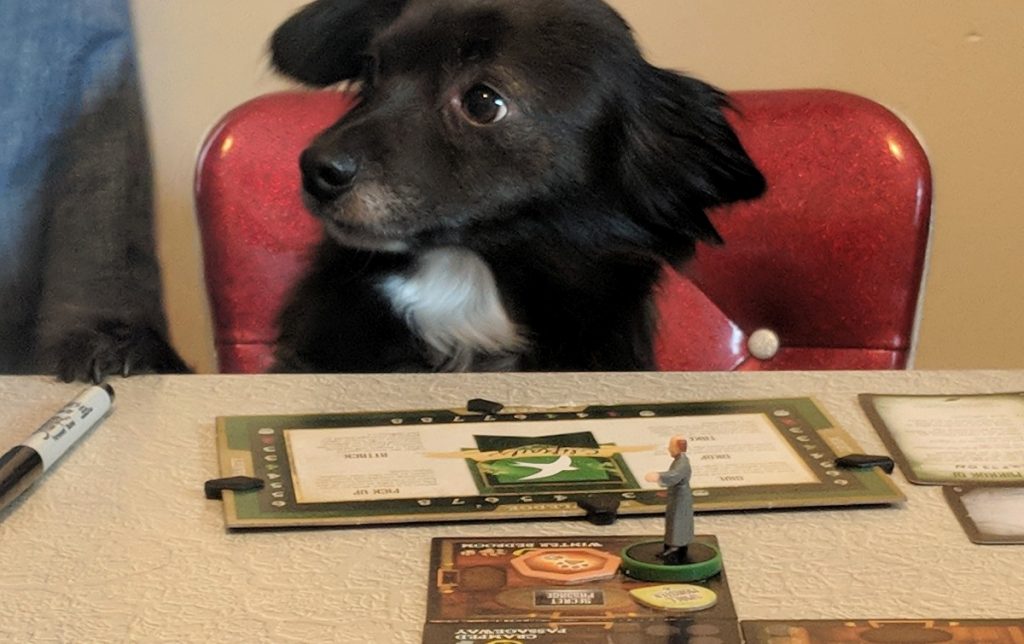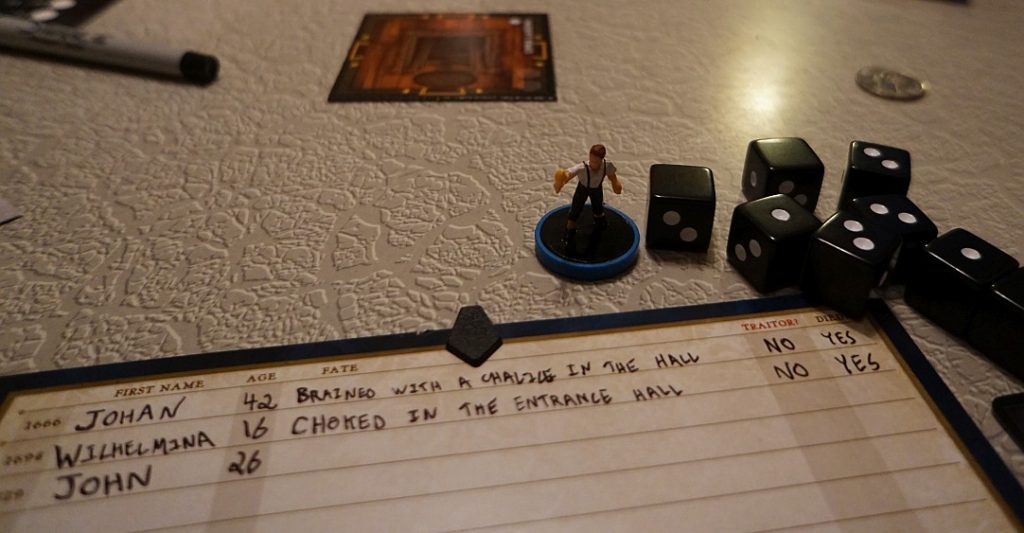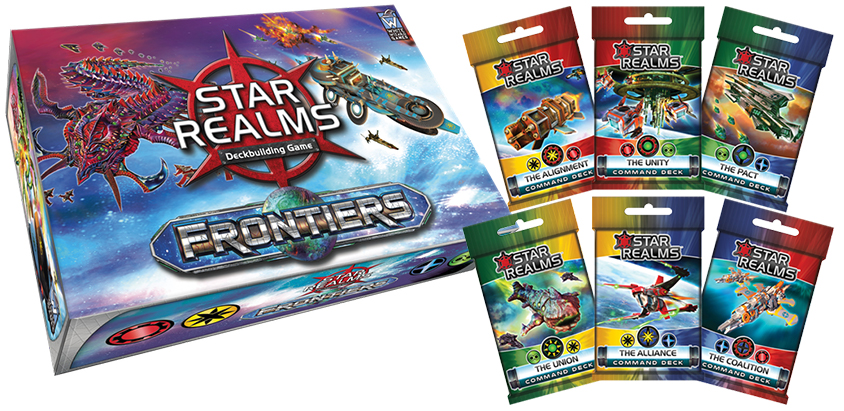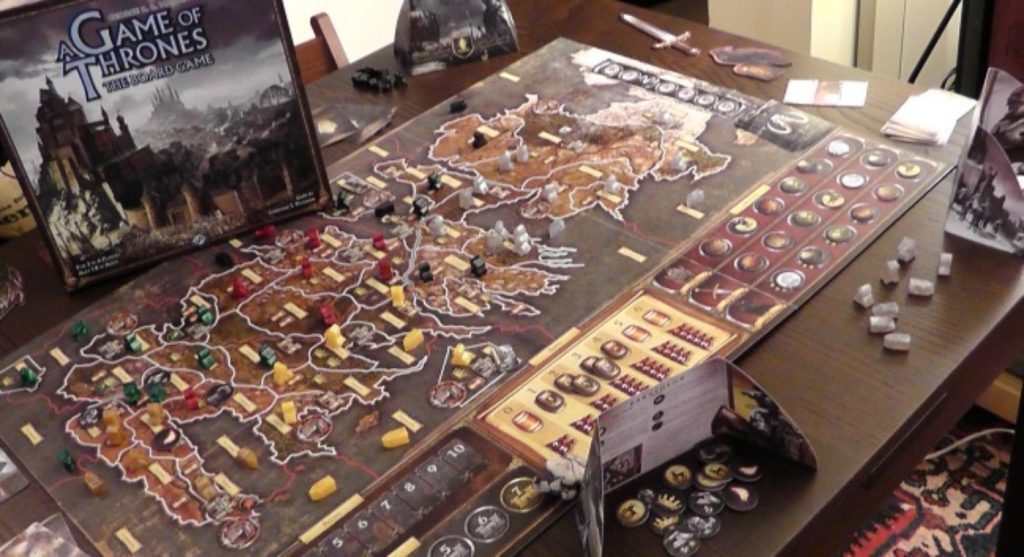[Hello everybody! Please welcome back Jon Bolding, the rogue who offered us reviews of Orléans and the World Wide Wrestling RPG. As a special Halloween treat, today we’re shoving him towards the campaign-powered sequel to Betrayal at the House on the Hill. Bwa-ha-ha…]
Bolds: Moving to live in a new place is stressful, nigh on terrifying. A place where the faucets turn differently, the light switches are in odd places, and your bed faces a wholly new wall.
Well, GET READY, because Betrayal Legacy is a game about moving into a new house over and over, forever, without end. A new house where the portraits leak blood, the attic is infested with gremlins, and even the ghosts have skeletons in their spectral closets.
In this game, players take on the role of families drawn to this terrible, supernatural house. Over 14 games, spanning time from 1666 to 2004, generations of this family will uncover the terrible truth of that place.
It’s a promising setup for a Legacy game, where each new play will add or destroy cards, have you writing on the board, and make other permanent changes to the components. Like a good series of horror movies, each game has thematic ties to the last without burdening itself in consistent characterization or elaborate mythology—though it does eventually build to a dramatic conclusion.
This is not a wholly new game. It’s a smoothed over, mechanically unified version of Betrayal at House on the Hill. It has improvements that make it far more appealing than the original game—better rules formatting and layout foremost among them.
On your turn you’ll move your character through the house, exploring and adding new locations to this sprawling mansion. As you do this you’ll delve into thick decks of cards to pick up helpful items or encounter haunted house stuff. (Not so much scary as surprising and gross, it has everything you’d expect from pulp horror: Puddles of effluent, terrible beasts, cackling devils, and indelicate depictions of mental health.) Items and events increase or decrease your character’s stats, like Sanity or Might, which are rolled as a pool of funny dice to resolve events and, more excitingly, conflicts between players.
Because eventually enough of the house’s Omen tiles will be explored that you trigger the “Haunt”. See, halfway through the game the rules will dramatically change: Generally, one player will become the traitor. That player will retire to a different room (in your actual, real-life house) with a special rulebook called the Traitor’s Tome, detailing what has gone terribly wrong this time. The other players will crack open the Secrets of Survival to read about how to make it out of the house alive.
Betrayal is one of the best, weirdest games there is for telling a horror story. The slow and spooky exploration is all preparatory, but it establishes a bespoke setup for the Haunt each time. Will the murderer strike out from the basement? Will there be an entire cult lying in the attic crawlspace? Any one of the other players could be the villain… so should you stick close to your friend, or stay as far away from her as possible? Will the arsenal of items you’ve collected aid you in defeating the traitor or speed you on your way to slaughtering your loved ones?
The game’s legacy elements are as good as any I’ve ever seen. They focus mostly on the story, adding an overarching narrative to the game and filling its piles of cards and rooms with new twists. The fun bits of narration, a whole book called The Bleak Journal and the read-aloud stories on cards, are genuinely entertaining, although some ring hollow because of how the story is structured. Clever mechanics work around the game’s ubiquitous deaths, making rooms in the house more memorable than they might otherwise be. The game’s event cards change and twist over time, adding some spice to yet another puddle of blood or spooky figure half-glimpsed. One of the most enjoyable bits is making items into heirlooms, where players claim an item so it’s more powerful for their family in future games. It’s not just a rifle, it’s Lil’ Johnny Benedict’s Rifle, remember, from the Haunt where I stood on the porch and shot you in the parlor?
None of those twists are as significant as mid-play rules changes we’ve seen in other legacy board games, but this rightly leaves the Haunts themselves in the limelight. There’s a greater frequency of cooperative or free for all Haunts where there is no proper traitor at all, or where the traitor is a secret, which is a very welcome change. A few genuinely new things pop up—the exterior of the house is finally in play, with its own weird locations, and inhabitants of the house other than the players can exist before the Haunt occurs. The game you start your Legacy campaign with is mechanically much the same as the game you end with, though sprawling and bloated by tens of new cards and rooms and objects. And that’s good! A common complaint with some of the last few legacy titles is that they aren’t enough of a game to be good the first few plays.
It’s because of that structure this might be the first legacy game I’m actually excited to continue owning after I’m done with it. Past legacy games have advertised your own unique copy at the end as a feature, but this is the first one I’ve actually believed that claim for. It’s genuinely exciting to know that having finished the campaign I’ve seen less than a third of the scenarios that come with the game—many of which don’t appear in any version of the campaign. I know I’m going to get rid of my copy of original Betrayal and just keep my copy of Legacy—that’s my new go-to when I want to play this game.
Oh, dear, but I’ve stepped on an Omen sentence with that last one. Let me just roll the Haunt dice… okay, that triggers the Haunt… turn to page 86 in the Bleak Journal… yep… I should have expected this.
It’s Haunt 66, the mid-review turnaround.
Sometimes it’s hard to want to play this game.
Sure, Betrayal Legacy does go to lengths to fix some of Betrayal’s worst excesses. Haunts are much easier to actually implement, with clear rules for what you should and shouldn’t share with others as you play them, and there are example Haunts to easily reference if you’re confused by any rules.
Sometimes Betrayal is great, but like a stranger with a machete, you’re sometimes left asking why you invited this guy to your beach party? Because sometimes he’s just going to start killing your friends, which, believe you me, really ruins the mood. Not everyone is going to be comfortable with Betrayal’s fast and loose attitude towards player elimination.
Also, Betrayal Legacy still has what Quinns once described as “the most dickheaded dice in all of board gaming.” It still has those horrible little clips that go on the edge of the character cards and will inevitably slip around, or tear the crap out of the cardboard, or both.
It still feels like you’re searching for the coherent board game you’re pretty sure should be in the box somewhere… Until, suddenly, a slimy tentacle of a game rears up out of the Haunt books and slaps you with an experience that might be precisely what you were looking for, or it might not. In addition to this, the Haunt phase can—and will—draw out for thirty minutes beyond what it should, and sometimes end in victory before a single full round passes.
That early exploration, where you build a house and encounter spooky things, can be really fun. You’re opening up a bag of horrors, thrusting your hand in, and seeing what you get. Oh no! A horrible glow from cracks in reality! Hurray, a warm fireplace! But sometimes you’ve made a bunch of choices and rolled a load of dice and gotten nothing fun in return. A series of card draws just pushes you out of the game, and by the time the Haunt starts you’re doomed to failure—unable to even meaningfully participate in the game’s finale, despite doing everything right. That’s a risk you run playing Betrayal Legacy, and it might leave a very bitter taste in your mouth.
In other words, Betrayal Legacy is still a festival of random chance mediated by small choices that frequently mean nothing, and of low-key exploration punctuated by surprises, some explosive, some a disappointing fizzle. It’s a continual illusion, giving you glimpses of how this could have been the perfect game if something had just gone a little differently. It’s a kind of gambling that makes me want to keep pulling the lever just to see what combination of awful it spits out next. It’s a game haunted by itself.
Though I can’t stress enough that Legacy is much improved over the original game, it’s also more expensive, and still carries so many of the original game’s problems. It’s one of the most odd and rough-hewn games of its size in board gaming, not sure whether it’s a storytelling engine or a truly competitive experience, it ends up somewhere uncomfortably in the middle of the two. There are lots of jagged edges. Betrayal Legacy makes the bold decision to embrace those bits, knowing full well the gaping wounds it’s going to come away with.
Betrayal fills a unique niche, especially now that it has a legacy component to it. There’s no single game I can recommend over it that gives the same experience with the same theme and mechanics—but there are games that replicate parts of it. Those looking for sprawling adventure campaign with cool fights will probably be better served by Gloomhaven. Those looking for one-versus-many horror will probably like Whitehall Mystery or Fury of Dracula. Those who want traitors will probably prefer Dead of Winter. Those who want spooky jokes about ghosts with friends will probably have just as much fun playing a few rounds of Mysterium.
If you want all of those things in one box? Betrayal Legacy is pretty much the only game there is. I just can’t guarantee you’ll have consistent, frustration-free fun with it. Though I knew every game I’d be disappointed by some aspect of playing it, I still wanted to play.
Like a naive teen going camping by a lake I was assured that, somehow? Everything would be all right.

